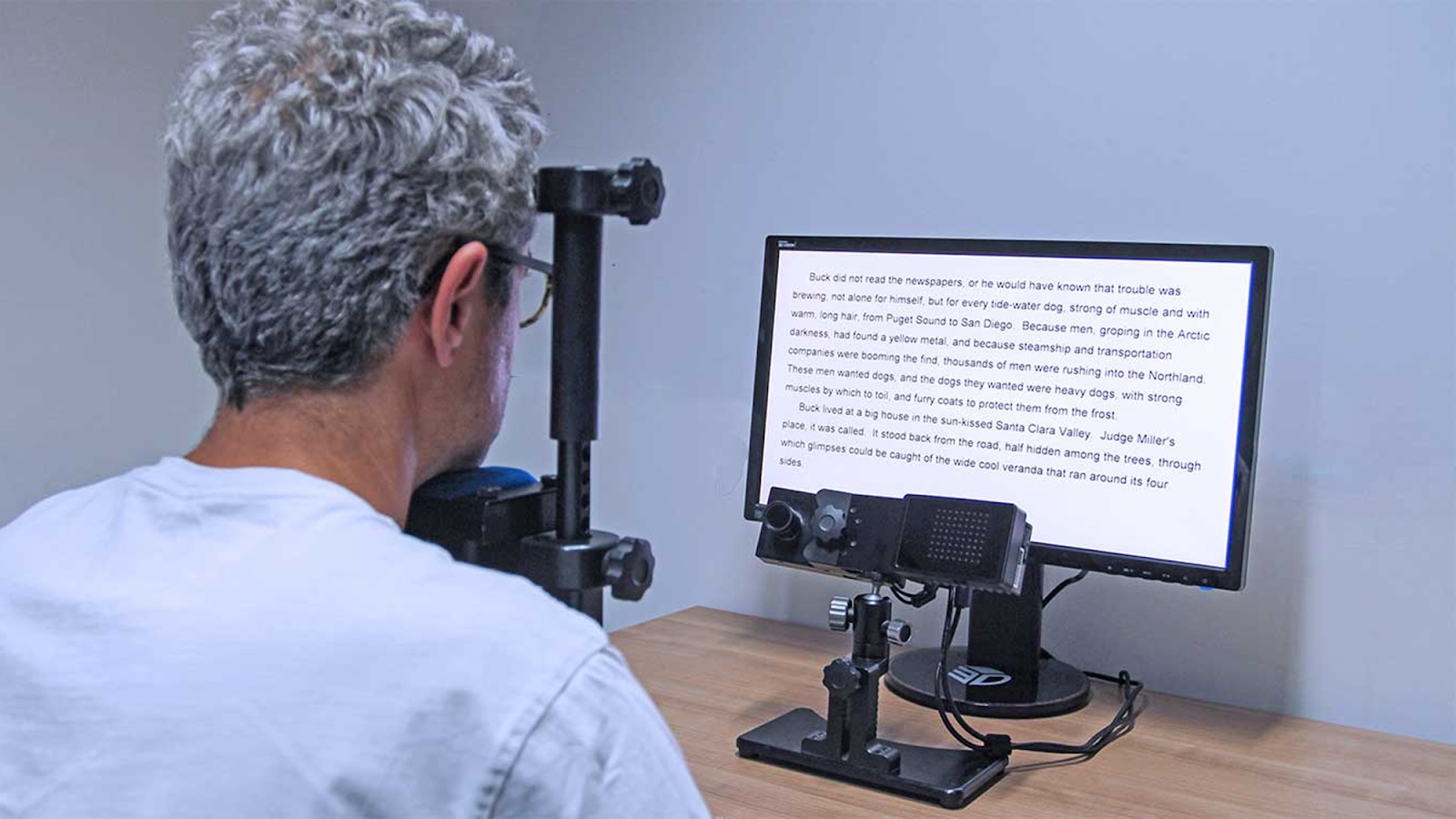Script Differences Hinder Language Switching in Bilinguals

Researchers at the HSE Centre for Language and Brain used eye-tracking to examine how bilinguals switch between languages in response to context shifts. Script differences were found to slow down this process. When letters appear unfamiliar—such as the Latin alphabet in a Russian-language text—the brain does not immediately switch to the other language, even when the person is aware they are in a bilingual setting. The article has been published in Bilingualism: Language and Cognition.
Bilinguals can differentiate between the target and non-target languages based on the global language context. In an environment where everyone speaks Russian, a bilingual fluent in both Russian and English will experience suppression of their English. In this context, Russian becomes the target language, while English remains the non-target language.
The researchers aimed to investigate how switching between target and non-target languages occurs when the global language context changes and to test the hypothesis of proactive gain control in bilinguals. This hypothesis suggests that as exposure to a non-target language increases, bilinguals activate its vocabulary to facilitate faster use. It is important that such control is exercised proactively rather than in response to already received information, and this helps prevent processing delays.
To test this hypothesis, the researchers conducted an experiment with a sample of 50 adult Russian–English bilinguals. Participants were asked to read several sentences on various topics displayed on a computer screen and answer related questions. Initially, participants' target language was Russian, but the researchers gradually altered the language context to make English the target language. Initially, Russian was the only language spoken to participants, and they were given task instructions in Russian. In the second stage, English sentences were introduced alongside Russian. In the third stage, English sentences were removed, but an English-speaking instructor joined the participants. In the final stage, participants were exposed solely to English sentences, and the experimenter spoke only English to them.
As participants performed the tasks, their eye movements were recorded, specifically the duration of gaze fixation on a word, the number of regressions to previous words, and any skipped words. It is known that longer fixations indicate greater difficulty in processing a word, while regressions suggest a need to revisit the word to better understand its meaning.

'The invisible boundary paradigm was used to measure access to the non-target language. While a participant was reading a sentence in Russian, an English translation of a word in that sentence briefly appeared before the target Russian word was displayed,' the authors explain.
For example, in the Russian sentence 'You will need to complete certain training to obtain a permit,' the English word training appeared before the Russian word for ‘training.’

The researchers hypothesised that if access to the English language was activated, the duration of fixation on the Russian word after the appearance of its English translation would be shorter. However, this hypothesis was not confirmed. Despite the gradual introduction of English elements in the experiment, changes in the linguistic context did not influence early lexical access.
'Probably, the difference between the Cyrillic and Latin scripts is too significant, causing the brain to immediately recognise the mismatch and automatically suppress the non-target script. Additionally, it is possible that the immersion in the non-target language was not prolonged enough for its activation,' the researchers suggest.
Thus, the study findings confirmed the key predictions of the Multilink and BIA+ models, namely that lexical processing in a bilingual environment is influenced by both bottom-up and top-down factors. However, bottom-up factors dominate when the scripts differ.
The bottom level involves automatic input processing, where the brain first recognises letters, followed by words, and then their meanings. In the case of different scripts, such as Cyrillic and Latin, the brain may struggle to recognise the letters of the non-target script. The difference significantly impacts how quickly and efficiently a person can switch between languages.
The top level involves conscious input processing, which relies on the global context and prior experience. For example, if a person knows they are in a bilingual environment, this awareness can activate an expectation in their brain of encountering a word in the second language. However, this process requires more time and effort.
The researchers plan to conduct experiments involving deeper immersion in a non-target language. 'We expect that after a certain point, we will observe an increase in the speed of cross-language switching,' explain the authors.
The findings from this and potential future studies may be valuable for developing strategies to teach foreign languages, particularly reading skills, by considering the cognitive load involved in suppressing the native language, script differences, and the duration of immersion in the language environment.
See also:
New Method for Describing Graphene Simplifies Analysis of Nanomaterials
An international team, including scientists from HSE University, has proposed a new mathematical method to analyse the structure of graphene. The scientists demonstrated that the characteristics of a graphene lattice can be represented using a three-step random walk model of a particle. This approach allows the lattice to be described more quickly and without cumbersome calculations. The study has been published in Journal of Physics A: Mathematical and Theoretical.
Scientists Have Modelled Supercapacitor Operation at Molecular and Ionic Level
HSE scientists used supercomputer simulations to study the behaviour of ions and water molecules inside the nanopores of a supercapacitor. The results showed that even a very small amount of water alters the charge distribution inside the nanopores and influences the device’s energy storage capacity. This approach makes it possible to predict how supercapacitors behave under different electrolyte compositions and humidity conditions. The paper has been published in Electrochimica Acta. The study was supported by a grant from the Russian Science Foundation (RSF).
Designing an Accurate Reading Skills Test: Why Parallel Texts are Important in Dyslexia Diagnosis
Researchers from the HSE Centre for Language and Brain have developed a tool for accurately assessing reading skills in adults with reading impairments. It can be used, for instance, before and after sessions with a language therapist. The tool includes two texts that differ in content but are equal in complexity: participants were observed to read them at the same speed, make a similar number of errors, and understand the content to the same degree. Such parallel texts will enable more accurate diagnosis of dyslexia and better monitoring of the effectiveness of interventions aimed at addressing it. The paper has been published in Educational Studies.
A Space for Economic Experimentation: LEEF Organises Workshop for Early-Career Researchers
In early September 2025, the renewed Laboratory for Experimental Economics and Finance (LEEF) held its first workshop for early-career researchers. Its main distinguishing feature was that every presentation was based on the results of laboratory economic experiments. In particular, the speakers discussed what people consider a fair deal, how best to motivate employees, and how genes influence the willingness to cooperate and help others. All interested students and postgraduates were invited to collaborate with the laboratory.
Internal Clock: How Heart Rate and Emotions Shape Our Perception of Time
Our perception of time depends on heart rate—this is the conclusion reached by neuroscientists at HSE University. In their experiment, volunteers watched short videos designed to evoke specific emotions and estimated each video's duration, while researchers recorded their heart activity using ECG. The study found that the slower a participant's heart rate, the shorter they perceived the video to be—especially when watching unpleasant content. The study has been published in Frontiers in Psychology.
Scientists Identify Personality Traits That Help Schoolchildren Succeed Academically
Economists from HSE University and the Southern Federal University have found that personality traits such as conscientiousness and open-mindedness help schoolchildren improve their academic performance. The study, conducted across seven countries, was the first large-scale international analysis of the impact of character traits on the academic achievement of 10 and 15-year-olds. The findings have been published in the International Journal of Educational Research.
HSE Researchers Determine Frequency of Genetic Mutations in People with Pulmonary Hypertension
For the first time in Russia, a team of scientists and clinicians has conducted a large-scale genetic study of patients with pulmonary arterial hypertension. The team, which included researchers from the International Laboratory of Bioinformatics at the HSE Faculty of Computer Science, analysed the genomes of over a hundred patients and found that approximately one in ten carried pathogenic mutations in the BMPR2 gene, which is responsible for vascular growth. Three of these mutations were described for the first time. The study has been published in Respiratory Research.
HSE Scientists Reveal How Disrupted Brain Connectivity Affects Cognitive and Social Behaviour in Children with Autism
An international team of scientists, including researchers from the HSE Centre for Language and Brain, has for the first time studied the connectivity between the brain's sensorimotor and cognitive control networks in children with autism. Using fMRI data, the researchers found that connections within the cognitive control network (responsible for attention and inhibitory control) are weakened, while connections between this network and the sensorimotor network (responsible for movement and sensory processing) are, by contrast, excessively strong. These features manifest as difficulties in social interaction and behavioural regulation in children. The study has been published in Brain Imaging and Behavior.
Similar Comprehension, Different Reading: How Native Language Affects Reading in English as a Second Language
Researchers from the MECO international project, including experts from the HSE Centre for Language and Brain, have developed a tool for analysing data on English text reading by native speakers of more than 19 languages. In a large-scale experiment involving over 1,200 people, researchers recorded participants’ eye movements as they silently read the same English texts and then assessed their level of comprehension. The results showed that even when comprehension levels were the same, the reading process—such as gaze fixations, rereading, and word skipping—varied depending on the reader's native language and their English proficiency. The study has been published in Studies in Second Language Acquisition.
Mortgage and Demography: HSE Scientists Reveal How Mortgage Debt Shapes Family Priorities
Having a mortgage increases the likelihood that a Russian family will plan to have a child within the next three years by 39 percentage points. This is the conclusion of a study by Prof. Elena Vakulenko and doctoral student Rufina Evgrafova from the HSE Faculty of Economic Sciences. The authors emphasise that this effect is most pronounced among women, people under 36, and those without children. The study findings have been published in Voprosy Ekonomiki.


